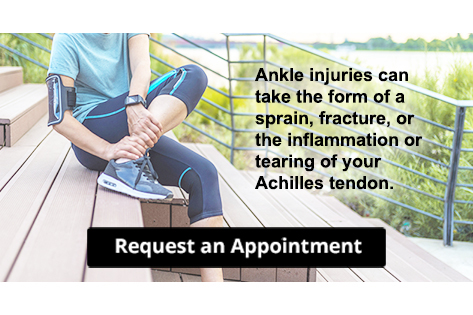Items filtered by date: August 2023
Exploring the Bones and Joints of the Foot
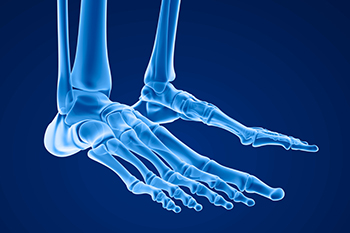
The structure of the foot comprises a fascinating network of bones and joints that enable us to walk, run, and stand. The foot has three major sections: the forefoot, midfoot, and hindfoot. The forefoot contains metatarsal bones forming the ball of the foot, while the midfoot houses various tarsal bones. The tarsal bones are responsible for maintaining arches and facilitating flexibility. The hindfoot houses the heel bone, or calcaneus, and is crucial for absorbing shock during movement. Other joints in the foot, like the ankle joint and the subtalar joint, allow for complex motions that include dorsiflexion and plantarflexion. Understanding this skeletal framework is essential for appreciating the importance of proper foot care and maintaining overall mobility and comfort. If you would like more information about the biomechanics of the feet, it is suggested that you consult with a podiatrist who can provide you with the knowledge you are seeking.
If you have any concerns about your feet, contact one of our podiatrists from Florida. Our doctors can provide the care you need to keep you pain-free and on your feet.
Biomechanics in Podiatry
Podiatric biomechanics is a particular sector of specialty podiatry with licensed practitioners who are trained to diagnose and treat conditions affecting the foot, ankle and lower leg. Biomechanics deals with the forces that act against the body, causing an interference with the biological structures. It focuses on the movement of the ankle, the foot and the forces that interact with them.
A History of Biomechanics
- Biomechanics dates back to the BC era in Egypt where evidence of professional foot care has been recorded.
- In 1974, biomechanics gained a higher profile from the studies of Merton Root, who claimed that by changing or controlling the forces between the ankle and the foot, corrections or conditions could be implemented to gain strength and coordination in the area.
Modern technological improvements are based on past theories and therapeutic processes that provide a better understanding of podiatric concepts for biomechanics. Computers can provide accurate information about the forces and patterns of the feet and lower legs.
Understanding biomechanics of the feet can help improve and eliminate pain, stopping further stress to the foot.
If you have any questions please feel free to contact our offices located in North Miami, and Pembroke Pines, FL . We offer the newest diagnostic and treatment technologies for all your foot and ankle needs.
Get Proper Treatment for Ankle Injuries
Pain in the Ball of the Foot
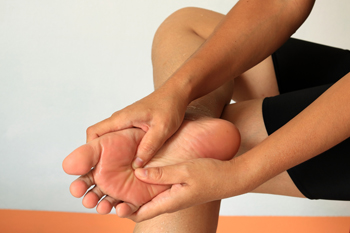
Much of the body's weight is supported by the metatarsals, the long bones of the foot. When these bones become inflamed or irritated, it results in a condition known as metatarsalgia, or more commonly, pain in the ball of the foot. This causes varying degrees of discomfort that can disrupt daily activities. Metatarsalgia is often seen in active individuals, as a result of overuse and high-impact activities like running and jumping. Constrictive footwear and high heels that create pressure around the metatarsals can also contribute to ball of foot pain. Being overweight increases the risk of developing metatarsalgia. Symptoms include pain between the toes and the arch, which can intensify during movement and ease when resting. Numbness around the toes, especially the big toe and second toe, is common. Stretching and strengthening foot muscles, as well as the Achilles tendon, are essential for recovery from metatarsalgia. Proper footwear with arch support can aid in cushioning the foot's arch and providing relief. Surgical options might be considered if other pain management remedies prove inadequate. If you are experiencing pain in the ball of the foot on a continual basis, it is suggested that you make an appointment with a podiatrist for a full examination and discussion of treatment options.
Foot Pain
Foot pain can be extremely painful and debilitating. If you have a foot pain, consult with one of our podiatrists from Florida. Our doctors will assess your condition and provide you with quality foot and ankle treatment.
Causes
Foot pain is a very broad condition that could be caused by one or more ailments. The most common include:
- Bunions
- Hammertoes
- Plantar Fasciitis
- Bone Spurs
- Corns
- Tarsal Tunnel Syndrome
- Ingrown Toenails
- Arthritis (such as Gout, Rheumatoid, and Osteoarthritis)
- Flat Feet
- Injury (from stress fractures, broken toe, foot, ankle, Achilles tendon ruptures, and sprains)
- And more
Diagnosis
To figure out the cause of foot pain, podiatrists utilize several different methods. This can range from simple visual inspections and sensation tests to X-rays and MRI scans. Prior medical history, family medical history, and any recent physical traumatic events will all be taken into consideration for a proper diagnosis.
Treatment
Treatment depends upon the cause of the foot pain. Whether it is resting, staying off the foot, or having surgery; podiatrists have a number of treatment options available for foot pain.
If you have any questions, please feel free to contact our offices located in North Miami, and Pembroke Pines, FL . We offer the newest diagnostic and treatment technologies for all your foot care needs.
Tips for Running With Flat Feet

Though running with flat feet can be challenging, it is possible to enjoy pain free runs and improve your athletic performance. Having flat feet can alter alignment of the lower extremities, which may result in strain on soft tissues and joints. Choosing the right shoes with adequate arch support is crucial. Proper running technique and posture are also essential for flat footed runners. A podiatrist can advise on the most suitable foot landing, whether forefoot, midfoot, or heel running, and help you to maintain an proper posture during running. Stretching after each run is recommended for flat footed runners. In addition, it is beneficial to alternate running surfaces, which may help to alleviate strain. Non impact equipment, such as elliptical trainers or stair machines, are other alternatives. If you are experiencing problems that stem from having flat feet while running, it is suggested that you make an appointment with a podiatrist who can offer custom orthotics that may address the issue and contribute to pain free running.
Flatfoot is a condition many people suffer from. If you have flat feet, contact one of our podiatrists from Florida. Our doctors will treat your foot and ankle needs.
What Are Flat Feet?
Flatfoot is a condition in which the arch of the foot is depressed and the sole of the foot is almost completely in contact with the ground. About 20-30% of the population generally has flat feet because their arches never formed during growth.
Conditions & Problems:
Having flat feet makes it difficult to run or walk because of the stress placed on the ankles.
Alignment – The general alignment of your legs can be disrupted, because the ankles move inward which can cause major discomfort.
Knees – If you have complications with your knees, flat feet can be a contributor to arthritis in that area.
Symptoms
- Pain around the heel or arch area
- Trouble standing on the tip toe
- Swelling around the inside of the ankle
- Flat look to one or both feet
- Having your shoes feel uneven when worn
Treatment
If you are experiencing pain and stress on the foot you may weaken the posterior tibial tendon, which runs around the inside of the ankle.
If you have any questions please feel free to contact our offices located in North Miami, and Pembroke Pines, FL . We offer the newest diagnostic and treatment technologies for all your foot and ankle needs.
The Ankle Ailment Known as Cuboid Syndrome
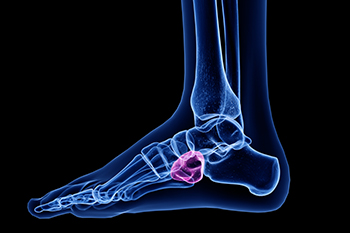
Cuboid syndrome, also known as cuboid subluxation or lateral plantar neuritis, is a relatively rare and painful condition that affects the cuboid bone in the foot. The cuboid bone is a cube-shaped bone located on the outer side of the foot, forming a vital part of the foot's structure and stability. Cuboid syndrome can be caused by various reasons. The cuboid bone can shift out of alignment by rolling or twisting the ankle or it can happen from overuse or repetitive stress. This is a common condition among ballet dancers, as a result of this type of dance style. Having poor foot biomechanics such as flat feet, overpronation, or other foot abnormalities also can disrupt the cuboid's positioning. Wearing shoes that do not fit properly can contribute to developing cuboid syndrome as well. Common symptoms include pain on the lateral side of the foot, difficulty in walking, and discomfort while bearing weight. Early diagnosis and appropriate treatment can aid in resolving cuboid syndrome effectively. If you have pain on the outside of your foot, it is suggested that you consult with a podiatrist for an accurate diagnosis and treatment options.
Cuboid syndrome, also known as cuboid subluxation, occurs when the joints and ligaments near the cuboid bone in the foot become torn. If you have cuboid syndrome, consult with one of our podiatrists from Florida. Our doctors will assess your condition and provide you with quality foot and ankle treatment.
Cuboid syndrome is a common cause of lateral foot pain, which is pain on the outside of the foot. The condition may happen suddenly due to an ankle sprain, or it may develop slowly overtime from repetitive tension through the bone and surrounding structures.
Causes
The most common causes of cuboid syndrome include:
- Injury – The most common cause of this ailment is an ankle sprain.
- Repetitive Strain – Tension placed through the peroneus longus muscle from repetitive activities such as jumping and running may cause excessive traction on the bone causing it to sublux.
- Altered Foot Biomechanics – Most people suffering from cuboid subluxation have flat feet.
Symptoms
A common symptom of cuboid syndrome is pain along the outside of the foot which can be felt in the ankle and toes. This pain may create walking difficulties and may cause those with the condition to walk with a limp.
Diagnosis
Diagnosis of cuboid syndrome is often difficult, and it is often misdiagnosed. X-rays, MRIs and CT scans often fail to properly show the cuboid subluxation. Although there isn’t a specific test used to diagnose cuboid syndrome, your podiatrist will usually check if pain is felt while pressing firmly on the cuboid bone of your foot.
Treatment
Just as the range of causes varies widely, so do treatments. Some more common treatments are ice therapy, rest, exercise, taping, and orthotics.
If you have any questions, please feel free to contact our offices located in North Miami, and Pembroke Pines, FL . We offer the newest diagnostic and treatment technologies for all your foot care needs.
2 Categories of Workplace Foot Injuries
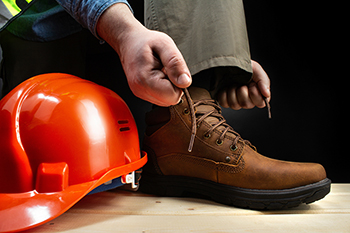
Studies show that many workman compensation cases involve the feet. The various injuries targeting the feet and ankles can be classified into two groups. Mishaps that happen from punctures, lacerations, and crushing is one category, while the other group results from slips, trips, and falls. Common injuries that happen can be crushed or broken feet as a result of falling objects or moving vehicles, and punctures on the bottom of the feet caused by sharp metal or glass objects. Wearing appropriate shoes may help to prevent many of these types of injuries. It is beneficial for employers to educate their employees about foot injury prevention policies. This can include the types of shoes that should be worn for the specific job. If you would like more information about additional foot protection while working, it is suggested that you confer with a podiatrist who can provide you with helpful tips.
While working on the feet, it is important to take the proper care of them. For more information about working on your feet, contact one of our podiatrists from Florida. Our doctors will treat your foot and ankle needs.
Working on Your Feet
Standing on your feet for long periods of time can cause stress and pain in your feet. Your whole body may experience change in terms of posture, back pain, bunions, callouses and or plantar warts. There are ways to avoid these conditions with proper foot care, smart choices and correct posture.
Positive Changes
Negative heeled shoe – Choosing this shoe type places the heel slightly lower than the ball of the foot. These are great for overall foot health. Find shoes that fit you correctly.
Go barefoot – Our feet were not designed to be enclosed for all hours of the day. Try to periodically expose your feet to air.
Eliminate Pain
Foot Exercises – Performing simple exercises, incorporating yoga and doing stretches are beneficial. This will allow increased blood flow to the area and muscles of the foot.
Achilles tendon – Stretching the foot out flat on the floor will relax the calf muscles and tendon. These exercises can be performed almost anywhere. Make sure you add these exercises to your daily regimen.
With a little bit of this information and knowing more about foot health, you will notice changes. Foot stretches and proper footwear will help with pain and prevent further issues.
If you have any questions please feel free to contact our offices located in North Miami, and Pembroke Pines, FL . We offer the newest diagnostic and treatment technologies for all your foot and ankle needs.
